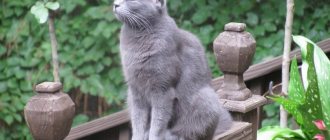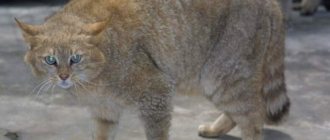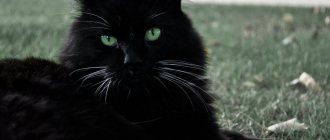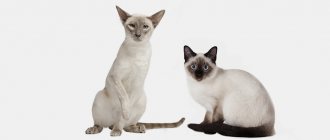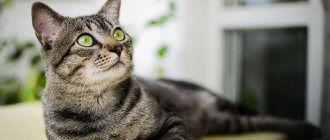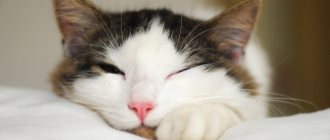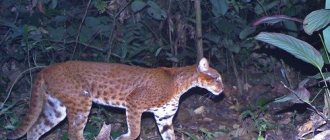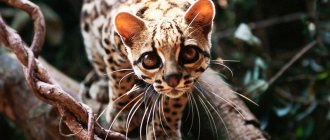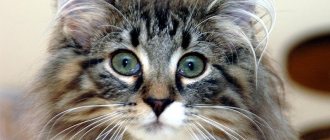History of the breed
There is a version that the first mention of these animals is found in the treatises of Siam and it was these animals that were brought to England in the nineteenth century under the guise of a chocolate Siamese. But the Siamese cat breed standard was formed in a different way and has undergone great changes.
Whether the Tonkinese cat is an “old” type of Siamese or not will never be known for certain, no matter how much felinologists argue.
In the sixties of the last century, Canadian breeder Margaret Conroy got a kitten by crossing Siamese and Burmese breeds and began to work on a new variety, naming it after the Vietnamese region of Tonkin. After the standard was written, many years of breeding work took place.
For fifteen years this cat was listed as a hybrid breed. True, this variety was originally called the “golden Siamese” because of its characteristic mink-like coat and color-point color.
The history of the name of the breed is romantic. In the USA there is a popular musical about the love of an American officer and a Tonkinese girl - the story takes place on the Pacific Islands. The moral of the story is the victory of high feeling over racial prejudice. The difficult fate of these cats, their long lack of recognition was the reason for this analogy. But the name “Tonkinese” was originally associated with the musical, in which the main character is a resident of Tonkin.
An Old Siamese cat named Wong Mau was brought to the United States of America by Dr. Joseph Thompson back in 1930. Her descendants became breeding animals - they were crossed with the Canadian line and the march of the Tonkinese cat began in America.
Today this breed is recognized by all felinological associations, but there are two standards: European and American.
Cat character
The Tonkinese cat is not like other breeds. She combines intelligence, talkativeness, flirtatiousness, playfulness, family, and an easy-going character. Pets move quickly along horizontal and vertical planes. For them, everything without exception is a toy. They love to play with a ball, they can fetch slippers, they are mobile and active. After playing, cats will happily lie close to their owner. They prefer to be petted, praised and talked to.
Such pets do not quarrel with other animals in the house.
The owners of Tonkinese cats claim that it is the mink cat that chooses its own family. Animals love attention from humans, are affectionate and friendly. They easily find a common language with kids and other pets, and become the best and most loyal friends with dogs. They do not like loneliness; it is not recommended to leave them alone for a long time.
Felinologists note that without proper attention, a mink or Tonkinese cat is prone to a depressed mood.
Features and breed standard
In terms of morphology, the Tonkinese cat resembles a Thai cat, but has a shorter and wider, slightly snub nose. This is an animal of medium size and constitution with a peculiar coat and a characteristic color point. Derived from crossing a Siamese and a Burmese, it is distinguished by its aquamarine eye color.
Description given to this breed by WCF:
- Head. Wedge-shaped, quite wide. The profile and cheekbones are quite softly outlined, the stop is small in size on the bridge of the nose.
- Neck. Medium size, strong and muscular.
- Eyes. Quite widely spaced, almond-shaped, but slightly rounded. The color must match the coat. From aquamarine to seawater color. Preferably clean and clear tones.
- Ears. The middle ones are wider at the base, tapering to slightly rounded tips. High standing, straight, not too wide apart. The fur on the ears is short, the ears appear translucent.
- Body. Medium build, muscular, with a toned stomach. Not elegant, but not massive either.
- Paws. Medium size, quite graceful, but strong, pads are round, but quite small.
- Tail. Medium size, proportional to the body, slightly tapering towards the tip.
- Wool. Short and shiny. Without undercoat, lying close to the body.
- Color. The main background is without a pattern, uniform, somewhat lighter on the inner parts of the body. The points—the “mask” on the face, the ears, paws, and tail—are darker, the transition from the main background to the points is smoothed out.
- Weight. Males are larger than females. From three to six kilograms.
- Knitting. Interbreeding only within the breed
- Flaws. Slight deformation of the tail, too heavy or graceful body, large snub nose.
Disqualifying signs:
- Yellow eye color
- White spots and medallions
- Tail break
- Aggressive behavior.
How to choose a kitten
Kittens have a very high level of adaptation.
After moving to a new place, the pet will quickly learn not only the character and habits of the owners, but also their rhythm, to which it will adapt.
Both young and adult cats will always be in the mood to fool around with their owner
When choosing, it is recommended to pay attention to the coat color.
For this breed it is customary to distinguish the following types of colors:
- natural mink: the fur has a basic warm brown tone with markings of a darker color;
- champagne mink: lighter beige coat with pale brown markings;
- platinum mink: pets are distinguished by a pale silver color with darker gray spots;
- blue mink: blue-colored fur with blue-gray markings.
Interesting! Color-point and Burmese kittens are also born in the litter, but they are prohibited from being used for exhibitions and breeding.
The most valuable are the mink color varieties.
It is also worth remembering that the final color is established only at 1.5 years of the kitten’s life.
How to determine the age of a kitten is described in the article
In addition, there is a tendency for a cat to darken with age.
The famous aquamarine eyes, which are the hallmark of this breed, are not present in all colors.
In some cases there may be a blue or greenish-yellow color.
Tonkinese cats are famous for having a well-balanced build.
They are medium in size, quite dense and muscular.
Therefore, when choosing a kitten, you should pay attention to the presence of distinctive features:
- The ears are quite large and tilted forward. They are set wide but neatly on the sides of the head. The ends should be rounded.
- The head is wedge-shaped. The contours are very soft and rounded. He has a strong chin and massiveness.
- The nose has a harmonious profile. The nostrils are more open, and the lobe itself is quite wide.
- The wool has a soft texture. There is no undercoat.
- The body is elegant and thin with well-developed muscles.
- The paws have a rounded shape. The legs are slender and long.
- The tail is long and thin at the base. Tapers towards the tip. The length should be approximately equal to the body.
The Tonkinese cat is incredibly graceful and well-built.
Prices for a kitten of this breed in nurseries start from 20,000 rubles.
This applies to the category of pets (pet class).
If you want a show-class kitten, the price will be completely different.
Moreover, not the least criteria in determining value are pedigree, external characteristics and gender.
Colors
This is the only cat whose six, one of the main advantages of the breed, are compared to a mink. It was the delicate shades of color and its brilliant gloss - glitter - that gave the colors such a name.
There are five main colors of the Tonkinese cat. Their characteristics:
- Natural mink. The main background is light brown, the points are dark brown. The abdomen and inner surfaces of the paws are lighter than the rest of the body. The paw pads and nose are light to dark brown.
- Honey mink. The main background is cream with a golden-apricot tint. The points are red-brown of varying intensity. The paw pads and nose are the color of pink caramel.
- Champagne. The main background is light cream, the points are light brown. The paw pads and nose are a cinnamon shade of varying intensity.
- Blue mink. The main background is light gray with a bluish tint, the points are darker, smoky blue. Paw pads and nose - match the background color.
- Platinum mink. The main background is silver-gray, almost purple. Points are the same color, but more saturated with a purple gloss. The paw pads and nose are pink to gray with a lavender tint.
Some felinological systems combine honey and champagne mink into one category. In addition, the Siamese type of color is sometimes recognized - with a clear contrast from the background to the points, a solid Burmese color. The mink color is often classified as a mink color.
The formation of colors is completely completed no earlier than one and a half years. Therefore, in kittens and young individuals, lighter background colors and faint spots in the points are allowed.
Features of behavior
Ocicat cat - description of the cat breed, red kitten
Tonkinese kittens are energetic and easy-going. They took the best features from their ancestors, Burmese and Siamese. They are sociable with both people and other animals.
Important! The owner's attention is attracted by soft meowing.
Cats of this breed get along well with children. Pets cannot stand quarrels and will try to hide when the atmosphere is tense. Therefore, you need to maintain a friendly environment.
Intelligence
The advantage of a Tonkinese pet is that they have a sharp mind. He easily masters various interactive toys, learns tricks and can be trained.
The owner can teach him to walk, and then the cat will accompany him when going to different places. The pet will easily understand commands, so it can be quickly weaned from bad things. For example, a Tonkinese will immediately understand that it is forbidden to tear up furniture.
Character
The Tonkinese has taken the best from both breeds that created it. He is energetic and active, like a Siamese, but more silent, obedient and flexible, like a Burmese.
The soft and loyal pet always tries to be close to its owner. Strives to be picked up and loves to sleep with people.
Just like the Siamese, they love to talk, but at the same time they make quiet meowing sounds and are not so intrusive. They will feel sad when they are alone, so it is better to have a couple of these cats at home or, in addition to Tonkinesis, buy other pets.
They are smart, quickly learn to use the toilet and scratching post, and love to go for long walks with their owner on a leash, if you instill a love for a harness at an early age.
Characteristics of Tonkinese cats
Tonkinese cats of the breed constantly strive to communicate with humans. These traits are typical of all Asians. They understand their owners without words; it is not for nothing that the Tonkinese are credited with telepathic abilities. They can easily determine a person’s mood by their voice and feel if the owner is upset about something. Pets react quite sharply to a tense situation in the house. When speaking in a raised voice, they try to soften the situation, begin to caress and jump into your arms. Often cats support the conversation of household members by making different sounds.
Intellectual abilities are observed even in a Tonkinese kitten , which, when entering a new home, studies each family member in order to select a path to their location. When breeding Tonkinese cats, breeders paid attention to the character of the animal. As planned, the Tonkinese kittens turned out to have a gentle disposition. They are not inclined to mischief like the Burmese and do not impose themselves on people, which is observed with the Siamese.
Because of its attachment to humans, the animal needs tactile contact with its owner. It is equally important for him to show his love and feel reciprocity. For this reason, you need to be prepared for the fact that you will have to share your bed with your pet. Spending time alone is painful for Tonkinese, so before leaving home you should prepare a corner with toys. It's even better to get some kind of animal for company. With him, the cat will definitely not be bored while waiting for his owners. Tonkinese cats do better in a large family with children and other pets than with a single person.
Among other equally unique qualities of the breed:
- high level of adaptation;
- ability to train;
- excellent memory;
- the ability to maintain a game with the owner, bringing your own rules into it;
- mobility and curiosity;
- stress resistance.
The most interesting aspect of keeping an Asian is the ability to walk him on a leash. Tonkinese cats are one of the few felines that accept dog equipment. Of course, walks are not so frequent (several times a month), but they give your pet real pleasure.
Education, maintenance and care
Tonkinese is very easy to care for. The wool has no undercoat, shedding does not bother either the owner or the animal. It is enough to remove sparse changing hair from the pet’s body with wet hands.
There is also no need for combing. To massage the skin, this procedure, if the cat likes it, can be carried out once a week. But this must be done carefully, with a brush with a soft hair base, so as not to damage the delicate skin.
You should not leave your cat alone near an open window, especially on high floors. Playfulness is characteristic even of older animals. If you get carried away with hunting for insects, they can easily fall out.
Tokinesis has virtually no drawbacks; its second name, Golden Siamese, suits it extremely well.
Character and education
The Siamese and Burmese gained their popularity precisely because of their behavioral qualities, and the Tonkinese combine the best character traits of their ancestors. Pets are distinguished by their lively intelligence, curiosity, independence and at the same time devotion to their owner.
The main skill of Tonkinese is companionship; if you allow, the pet will climb on your head to get a better look at how you peel potatoes. So, the first point is education. You will not be able to convince your pet that following you around is bad, and even if it works, the ward will continue to “bend his line” with a more conscientious expression on his face, however, it is extremely necessary to outline the “frames of decency”. Remember, fun is a kitten sitting on your shoulder, but an adult kitty clutching your back with its claws is already painful.
If you are already scared, don’t be, raising and training a Tonkinese cat is an exciting theatrical game, not a job. Pets are very observant, which also sometimes frightens their owners; as soon as you think about a sandwich, and the cat goes to the refrigerator - does he read your mind? No, it just knows your facial expression when you want to eat.
Draw your conclusions! If your pet has done something wrong, your face and behavior should show disappointment and resentment. A distinctive feature of Tonkinese is the lack of desire to “mischief” even out of resentment; on the part of the owner, a one-time negative reaction is enough to prevent the situation from repeating itself. The same can be said about your tone of voice, a little severity and the pet will reconsider its behavior. However, be responsible and do not joke with the sensitivity of the ward.
Pets have a tendency to avoid conflicts at all costs, most often through cunning. Tonkinese kittens that have recently come into the home will closely examine each family member and find weak points, by pressing on which they will avoid confrontation in the future. Pets have excellent memory and retain their “knack” until old age. The “opportunist” trait is also used in pet therapy; cats find an approach to children suffering from autism and other mental disorders.
The breed is not suitable for people with an overly active pace of life. Tonkinese dogs have a hard time with the daily absence of their owner, let alone going on vacation or a business trip. You can brighten up the loneliness of Tonkinese and get a second cat, this is a guarantee that the pets will not be bored while you work. Attitudes towards dogs are quite individual and depend on the similarity of the four-legged characters.
Health and nutrition
Any cat can eat natural food. But in this case, it is very difficult to organize a balanced diet; it is necessary to use additional special supplements and vitamins. Therefore, after kittens are weaned from their mother, they are gradually transferred to super-premium dry ready-made food.
These are heat-loving animals; drafts should be avoided. Prolonged exposure to the sun is also useless - delicate fur can fade.
No characteristic diseases have been noted in this breed. As you age, gum problems may arise. To prevent them, you should be attentive to your pet and promptly contact a veterinarian.
To prevent diseases it is necessary:
- deworm the animal once every three months;
- regularly treat external parasites;
- Be vaccinated annually against rabies and all known feline infections.
Care and maintenance of the Tonkinese cat breed
Tonkinese kittens and adult cats need to be brushed periodically with a stiff brush to remove dead hair. Such procedures are due to the lack of undercoat and the thickness of the coat. Pets are not delighted with such events, but they are mandatory. You can also use a damp massage glove for cleaning; it disturbs the animal less.
It is worth noting the cleanliness of the Tonkinese cat. She devotes a record amount of time to personal hygiene procedures. Therefore, there is no need to bathe your pet again. A bath day is arranged exclusively for heavily soiled conditions using a special shampoo. You should not overuse detergent so as not to spoil the fur. 5 ml is enough for one procedure.
Basic care also includes regular home checks and visits to the veterinarian. But timely vaccinations and preventive measures will help protect your pet from health problems and prolong its life.
The lifespan of cats is on average 13-16 years.
It is recommended to choose one of the options as food for representatives of the breed:
- balanced dry food or canned food;
- natural unsalted food with a vitamin complex.
You cannot include both types of food in your diet.
Tonkinese diseases
The Tonkinese cat is characterized by good health. If all care recommendations are followed, he practically does not get sick unless there is a genetic factor. But this does not mean that the animal should be ignored. According to reviews from veterinarians, Tonkinese cats have low immunity to upper respiratory tract diseases. There are also some problems with teeth. Periodic home inspections will help prevent serious situations, which will allow earlier treatment to begin when a problem is identified.
Conclusions about the Tonkinese breed
global $ads_google;
//data-ad-slot=”2475549904″ $ads_google = empty($ads_google) ? false : true; ?> if ($ads_google == false) {?> $ads_google = true; ?> } ?> The Tonkinese cat is truly unique and interesting. It’s never boring with such a pet: his playfulness and curiosity draw even adult family members into the game. You will have to verify the intellectual abilities and insight of your pet more than once. You shouldn’t be stingy with praise, because cats are so eager for affection and attention. In return, you can get a whole heap of pleasant memories and emotions; with age, the pet does not cease to remain a mischievous kitten.
Cost of a kitten
Despite the wide distribution of the Siamese breed, it is almost impossible to find real Tonkinese in our country.
If you want to become the owner of just such a pet, you should contact one of the nurseries in the United States of America, Canada or Europe.
The cost of a pet-class kitten will not be less than five hundred dollars; animals of the breeding class (for breeding) and show classes will be sold at a price of eight hundred dollars and more.
Nutrition Description
Veterinarians remind us that proper feeding is the key to the good health of every animal. Homemade food, sweet and salty foods are not recommended as they cause gastrointestinal problems. It is advisable to feed a mink cat natural food. The diet includes chicken, meat, rabbit, lean pork, beef or fish. Before serving, the meat is boiled. Fermented milk products and low-fat cottage cheese, eggs, and milk porridge will be useful. The cat can also eat specialized dry food and canned food. They must be of high quality due to the risk of developing the disease gingivitis. The cat is given a separate vitamin complex.
Exterior of a cat
Tonkinese cats have a truly exquisite appearance. Noble coloring, sophisticated exterior, turquoise or aquamarine eyes - all this together can cause admiration even among a sophisticated connoisseur.
Tonkinese inherited elegance from Siamese cats, and rounded and smooth lines of the exterior from Burmese cats. As a result, the Tonkinese cat looks more harmonious than both of its predecessors. The wedge-shaped head from the front has a triangular shape. Her large and bright almond-shaped eyes of greenish-blue shades stand out. Eye color usually depends on the coat and ranges from yellow-green to blue with greens. The average weight of cats is 3–4 kg, males – 4–6 kg.
Origin also played a role in the variety of Tonkinese colors. If the exterior of all representatives of the breed is the same, then the color is very different. There are three main types of color: mink, Burmese sepia and colorpoint inherited from the Siamese.
Each color has several color variations. The most prestigious are the four variations of mink recognized by international federations: champagne, platinum, natural and blue mink.
Health of the Tonkinese
Unfortunately, Tonkinese dogs do not have very good health. They can inherit some dangerous diseases and are also susceptible to some intestinal and respiratory infections. With proper care and care, the life expectancy of the Tonkinese is about 12 years.
Gingivitis
Gingivitis is an inflammation of the gums, one of the symptoms of periodontal disease. It appears as redness of the gums around the teeth. Very often, gingivitis affects not only the gums, but also bone tissue.
gingivitis is an inflammatory disease of the gums
Most often, gingivitis occurs for the following reasons:
- lack of oral hygiene;
- congenital malocclusion;
- vitamin deficiency (especially lack of vitamins A and C);
- the appearance of tartar;
- gum injuries;
- infections and viruses;
- old age and poor nutrition.
Gingivitis is treated with special medications. During treatment, be sure to feed your cat only soft pureed food and perform daily oral hygiene.
Burmese skull defect
Tonkinese cats inherited this genetic disease from Burmese cats. Burmese Head Defect (BHD) appears at a very early age (1–2 weeks) due to a mutant gene that is inserted into the cat’s genome and triggers the process of improper formation of the skull.
Burmese skull defect appears at an early age
The manifestation of a skull defect depends on the number of copies of the mutant gene. If a cat has only one copy of the gene, then it develops brachycephaly (short head, like Persians and exotics). If there are 2 copies, then the kitten inevitably dies from deformations of the skull incompatible with life.
A test has now been developed that can detect a mutant gene in a cat’s genome. Cats with this gene cannot be used for breeding.
Inflammatory bowel diseases
Experts are still arguing about what exactly causes IBD. At the moment, the objective cause is considered to be a negative intestinal reaction to food ingredients, chemicals, medications, etc.
IBD symptoms:
- diarrhea;
- vomit;
- weight loss;
- stomach ache;
- the presence of bright red blood during bowel movements;
- animal passivity;
- rumbling in the stomach, gases;
- weight loss.
Treatment is carried out by changing the diet and special medications. The exact treatment is prescribed by the veterinarian based on the individual needs of the cats.
Upper respiratory tract infections
Upper respiratory tract infections affect a cat's nasal passages, throat, and sinuses. Caused by certain feline viruses that a cat can become infected with. As a rule, infection occurs from animal contact with sick cats or with things that a sick cat has been near.
Symptoms:
- discharge from the nose and eyes;
- frequent coughing and sneezing;
If your cat is constantly sneezing and coughing, this could be a sign of an upper respiratory tract infection. - in more serious cases: fever;
- yellow-green nasal discharge;
- enlarged lymph nodes.
The disease is very dangerous if left untreated. At the slightest suspicion of infection, you should contact your veterinarian.
Amyloidosis
Amyloidosis is a rare disorder of protein metabolism. When it occurs, amyloid protein accumulates in the pancreas, kidneys or liver. This causes organ dysfunction. Amyloidosis can occur for the following reasons:
- hereditary disease;
- severe or chronic poisoning;
- reaction to serious infections.
Older animals are most often affected. Symptoms:
- anorexia;
Anorexia is common in cats with amyloidosis. - lethargy;
- sudden weight loss;
- severe shortness of breath;
- excessive thirst and a sharp increase in urination;
- yellowness of mucous membranes;
- lack of appetite and lethargy;
- deterioration of the condition of the cat's fur and hair.
The disease is considered incurable, you can only alleviate its symptoms.
Hypertrophic cardiomyopathy
Hypertrophic cardiomyopathy is the most common and is characterized by thickening of the walls of the heart, causing it to work worse and not be supplied with oxygen.
Hypertrophic cardiomyopathy affects a cat's heart, making it less elastic
Symptoms can be detected in the early stages by a veterinarian:
- galloping heart rhythm;
- arrhythmia;
- pulse pathology;
- heart murmurs;
- hypertension.
Cardiomyopathy is often observed against the background of other diseases: acromegaly, bull's heart, lymphoma. It may occur due to bad heredity. By treating the underlying disease, cardiomyopathy can be significantly alleviated and even eliminated.
Toyger cats
Toyger cats were obtained by selectively crossing Bengal individuals with Indian brindle cats. This is an external analogue of a tiger , only in miniature. The breed was officially recognized in 2007, and they appeared in our country a year later.
Description of toygers and colors
These are cats with a brindle color - they have clear dark brown stripes on a golden background. Their fur is extremely soft, silky and short. The toyger cat is characterized by a large build. The female weighs on average 5 kg, the male – 7.5 kg. They clearly have large bones, a wide chest and muscularity.
Standard breed parameters:
- The head is small, with prominent cheekbones and an elongated structure. The neck is narrow and elongated.
- Ears with rounded tips, without fur tassels.
- The eyes are deep, round, small, slightly drooping along the upper eyelid.
- The nose is gracefully elongated, with widened nostrils.
- The body is strongly built, elongated, prominent. There are soft curves throughout and the chest is wide. The paws are of medium length, identical, with dense fur.
- The tail is dense, long, bluntly ending. His usual position is down.
- The wool has a glossy sheen. There is no undercoat, and all hairs are the same length, with the exception of the stripe area. Due to this, a relief effect is created.
The predominant color of Toyger cats is golden, with chocolate or resin tiger stripes. The fur on the belly is much lighter. Toygers should have a clearly visible color pattern. The striping has a vertical direction and continues on the stomach and paws. The tip of the tail and paws are painted in ink color. True toygers always have a butterfly-like mark on their face. There are lightened circles around the eyes. The cheeks, chin and neck are lighter.
Characteristic behavioral features
Despite the analogy with tigers and their outward wildness, these are quite adequate and friendly animals. They love to participate in children's active games and are always the first to greet guests. However, they do not need constant attention and affection. They are not prone to aggression and will not scratch or bite. They can easily coexist with any pets.
Toygers are very curious and sociable, but not intrusive. They quickly get used to any living conditions and are undemanding in care. Therefore, it is an ideal choice for both city apartments and private houses.
It's amazing that these cats simply cannot live without water. They will be happy to take a bath with their owner. If there is an aquarium in the house, then the toyger cat will immediately splash around in it. This came to them from Bengal cats, who in ancient times lived on the banks of reservoirs. Another feature is the production of non-standard sounds when communicating with the owner. Along with purring, they begin to chirp and click.
Features of the Tonkinese cat breed
For those who are accustomed to seeing an independent cat in their pet, which “you can’t find in the daylight,” this breed is not suitable. On the contrary, buy a Tonkinese cat .
Who has other animals, and often has guests in the house. Tonkinese easily finds a common language with everyone. He will accompany you to work, try to fall asleep on your sofa, babysit your children, and even learn to fetch toys and small things in his teeth.
The photo shows the colors of the Tonkinese cat
Surprisingly, American researchers are confident that Tonkinese are real psychics. And at the same time they have telepathy. Observing the animals, experts noted that cats can predict the actions of their owners several steps ahead.
At the same time, they try to protect their beloved household members from negative energy. And even make peace if someone in the family is quarreling. Tonkinese doctors in the USA treat children suffering from autism and paralysis. It is believed that cats help children adapt to our harsh world.
The Tonkinese cat has an amazing character. She is smart, playful and has a sweet cat-like voice. They also do not harm the owners. If a cat is scolded for an offense, he will never repeat his mistake again.
At the same time, representatives of this breed are distinguished by excellent memory and adapt to the rhythm of life of their household. Truly kind cats should be protected from the outside world themselves. They can easily become prey on the street, so "free range" for Tonkinese is exceptional.
Care
Ragdoll (cat): description of breed and character
The cat does not need to be bathed frequently, as this washes away the protective layer from the skin. It is enough to comb the coat once a week. You can only bathe your pet if it is seriously dirty.
The eyes and nose are carefully wiped once a week with a wet cloth. There is no need to clean the ears, and if there are noticeable black spots inside, then this is a reason to go to the vet.
Non-breeding animals must be castrated or sterilized
It is easy to train your pet to use the tray. He will be a clean and exemplary inhabitant of the house. You definitely need to buy a scratching post and other toys, this will diversify your cat’s leisure time.
Important! Tonkinesis should not be allowed to roam freely. He may be hurt by dogs, hit by a car, or become a victim of knackers. The walk must be supervised by the owner.
Feeding
The Tonkinese breed is not picky. The pet can be fed with both cat food and natural food. It is important that any food is of high quality and natural.
The main part of the diet is meat and offal, 10% raw vegetables and fermented milk
You cannot give sausage, fatty foods, bread, chocolate or any food from the table. All this leads to obesity, metabolic disorders and malfunctions of internal organs.
If the owner decides to give industrial feed, then you need to choose super-premium or holistic brands. They are distinguished by a balanced composition that provides the animal with all the necessary substances.
Reviews from owners about the breed
OLYMPUS DIGITAL CAMERA
Olga, owner of a Tonkinese cat named Jasmine, 1.5 years old:
Golden girl! I have never met a better character in a cat! For a year and a half, she has never scratched anyone and tolerates a two-year-old child. And how affectionate! Follows me like a dog, sometimes “talks”. True, he doesn’t tolerate loneliness well, he’s sad... We need to get a second Tonkinesis. She is also very graceful, her muscles are flexing! And the wool looks and feels like mink!
Mikhail, owner of the cat Pusha, 3 years old:
Playful to the point of impossibility, curious - he pokes his nose everywhere, funny and our everyone's favorite. For three years, no health problems, eats everything, is not picky, but never overeats. He likes it when there are a lot of people at home - he is the center of attention.
We recommend watching a video about the Tonkinese cat breed, we wish you a pleasant viewing.
Video
Buying a kitten
Tonkinese cats have a peaceful nature, which makes them very popular. The average cost of a kitten is 35 thousand - 45 thousand rubles.* For this amount a person will receive a healthy purebred animal.
Nurseries
The most famous breeder is N. Peskova. She is the owner of the Edelweiss nursery, which is located in St. Petersburg. Her cat Julius was brought from the USA. All kittens are distinguished by high characteristics, they are healthy and meet the breed standard. In Moscow there are famous nurseries “Kornelita” and “Tonkibest”.
Important! You should not purchase animals from someone other than a breeder, as there is a risk of falling for a scammer.
Criterias of choice
You need to choose an active, inquisitive kitten from the litter. If he is not afraid to approach a stranger, is interested in everything new and attracts attention, this is an ideal pet.
The cat will be slightly larger than the cat
Many breeders offer lifetime consultations. They will tell you how to solve a particular behavior problem, competent veterinarians and other specialists.
Breeding
The best age for mating Tonkinese cats is 1.5 years. At this age, the body is fully strengthened and formed, and therefore the offspring will be healthy. Mating is best done during the cat's third heat (the optimal period). It is not worth delaying for a long time and waiting for a more favorable moment, since late labor is often difficult.
Mating lasts 2–3 days. The cat is usually brought to the cat (since the male feels more confident in his territory), and during this time the animals are left together. Care should be taken in advance to ensure that the animals have enough food and drink for several days. It is advisable to refuse the services of an instructor: representatives of this breed love privacy.
The first signs of pregnancy appear 3 weeks after mating. The cat becomes more lethargic and detached, moves little, eats more. At this time, the basis of the diet should be food high in calcium and protein. Pregnancy lasts on average 9 weeks. Usually 6 kittens are born.
Owners who plan to breed cats should take this issue seriously. Before mating, you need to make sure that the pet is completely healthy and vaccinated. You should also make sure that the partner does not suffer from any ailments (it is advisable to look at the vaccination data in the veterinary passport) and has good genetics. I strongly recommend that beginners consult with a veterinarian or breeder during a cat’s pregnancy regarding housing conditions and care features.
History of creation
The Tonkinese cat has an interesting history. Officially, the first kitten of this breed appeared in 1960. However, you can find references in literature dating back to the 16th-18th centuries.
The first Tonkinese cat in US history is considered to be the Wong Mau kitten. His owner, breeder Margaret Conroy, had a modest Siamese cat who liked only the Burmese male. At the same time, the kitten took only the best qualities from its parents. Later, the new breed of creature was presented to Joseph Thompson.
Burma
The Burmese have a strong, muscular body. The coat is short and shiny, usually brindle in color. The muzzle is round with pointed ears and large bright yellow eyes. The Burmese is distinguished by its playfulness and affection for its owner.
Siamese cat
The Siamese cat has a thin body. The coat is the same short and shiny, but the color is different (the body is light and the paws are dark). The muzzle is long with pointed ears and beautiful bright blue eyes. However, unlike the Burmese, the Siamese pet cannot be called playful and affectionate.
The breed was originally called the Golden Siamese. However, in 1971 Margaret Conroy renamed it Tonkin. There are two versions of the origin of the name of the Tonkinese cat breed:
- some believe that the name comes from the Vietnamese city of Tonkin;
- others - from the Gulf of Tonkin.
The first option is considered generally accepted.
Initially, the Tonkinese cat was not recognized and did not want to be allowed into competitions, because they considered it a “hybrid”. It was believed that mixing two breeds leads to a decrease in the quality of the cross product. Later, they began to register her in clubs.
